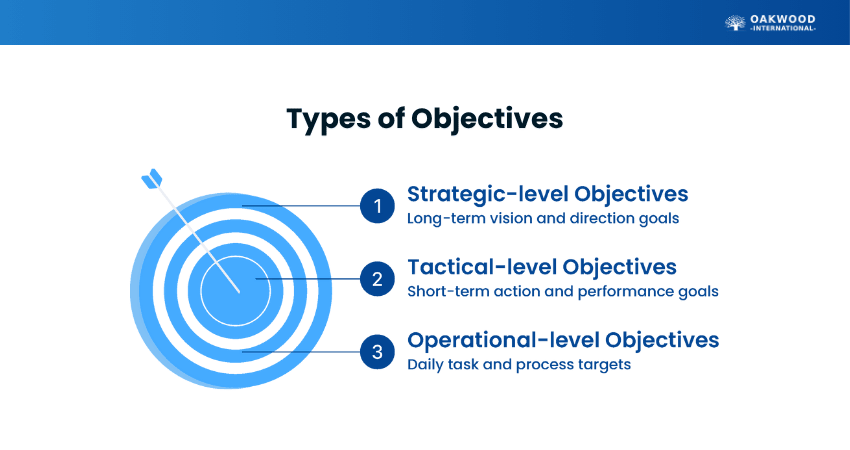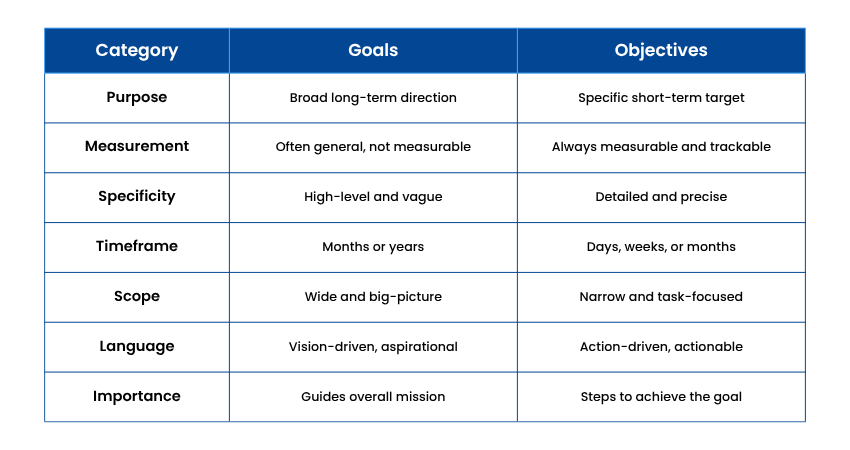Table of Contents


Have you ever dreamt of getting fitter or growing your career but felt stuck since you did not know where to begin? Well, you are not alone. This is where Goals vs Objectives play a crucial role. Goals give you the destination, while Objectives break the Goal down into providing steps to accomplish it.
In this blog, you will explore Goals vs Objectives, their types, differences and how to measure them. If you look forward to turning your vision into reality or simply, keep reading ahead to equip yourself with the right knowledge.
What is a Goal?
A Goal is a long-term result you set to achieve. Unlike small tasks, Goals take months or years to accomplish. They are broad in nature and future-focused. A Goal is often connected to your personal or organisational vision. Goals provide you with a clear purpose. In a nutshell, a Goal gives you direction, helps you stay focused, and motivates you to work towards the bigger picture.
Types of Goals
When you are about to set Goals, you must be aware of their types. Each type has its own priority. Always remember, no matter the type of Goal, aim to make your Goals SMART (Specific, Measurable, Achievable, Realistic, and Time-bound).

1) Time-based Goals
This type of Goals focuses on what is needed to achieve within a timeframe. They are driven by deadlines for helping you stay on track and manage priorities efficiently. It helps to set clear expectations for making progress. For example, completing a certification within the timeframe of three months.
2) Outcome-focused Goals
This type is focused on the result. While deadlines are a part of it, achieving the desired result is the primary aim. These Goals are suitable for setting major milestones and strategic targets, where quality and impact are the main interests. For example, increase customer satisfaction to 90 per cent.
3) Process-focused Goals
These Goals focus on how the work is carried out. They help to build positive habits, structure workflows, and create systems to keep you on track. Such Goals support long-term improvement by promoting consistency. For example, implementing a new project review process to improve overall team efficiency.
What is an Objective?
An Objective refers to a clear and measurable target for achieving a larger Goal. It provides practical, actionable steps within short timeframes. By breaking Goals into smaller, manageable tasks, you gain clarity over what to do, how to do it, and when to complete it. This also includes clearly defined actions and success criteria, making progress easier to track and helping you remain accountable.
Master effective performance appraisal skills with Performance Appraisal Training – join now!
Types of Objectives
For guidance, planning, and execution, objectives can be set at different levels. Each type focuses on a particular aspect of achieving a Goal. The main types are:

1) Strategic-level Objectives
These are high-level targets designed to support the vision of a project. The focus is on long-term direction, guiding decisions and ensuring daily efforts are in alignment with broader Goals. They mostly work with the why of the work or Goal. For example, expanding market presence by launching services in three different regions.
2) Tactical-level Objectives
Tactical Objectives are short-term and result-oriented. They bridge the gap between strategic planning and daily operations. By turning strategic Goals into practical steps, it helps teams to track progress, adjust plans and make smarter decisions. For example, increase website traffic monthly by 15 per cent.
3) Operational-level Objectives
These are action-oriented and very specific. Its focus lies on routine tasks and processes. This type of Objective manages daily, weekly and monthly work by organising schedules, resources and responsibilities. For example, respond to customer support tickets within 24 hours.
Difference Between Goals and Objectives
Goals and Objectives work in tandem, but they have differences between them. By understanding differences, will help you carefully plan and achieve your desired vision or results. Some of its key differences are listed below:

1) Purpose
Goals define the broad, long-term direction for an individual, team, or organisation. They represent the vision and ultimate destination you want to reach. For example, become a market leader in sustainable products.
Objectives break down that vision into specific, short-term targets. They are actionable milestones that help you move toward the Goal. For example, increase sales of eco-friendly products by 20% in the next quarter.
2) Measurement
Goals are often qualitative and not easily measurable. They describe what you want to achieve without specifying exact metrics.
Objectives are always measurable and trackable. They include clear criteria for success, such as numbers, percentages, or deadlines. For example, reduce customer complaints by 15% within six months.
3) Specificity
Goals are high-level and vague, focusing on the big picture rather than details. They answer the “what” and “why” questions.
Objectives are detailed and precise, answering the “how” and “when” questions. They outline specific actions and timelines.
4) Timeframe
Goals typically span months or years, as they represent long-term aspirations.
Objectives have shorter timeframes, days, weeks, or months, because they are actionable steps toward achieving the larger Goal.
5) Scope
Goals have a wide and big-picture scope, encompassing overall strategy and vision.
Objectives are narrow and task-focused, concentrating on specific actions that contribute to the broader Goal.
6) Language
Goals use vision-driven, aspirational language. They inspire and motivate, often sounding ambitious and future-oriented.
Objectives use action-driven, actionable language. They are practical, clear, and focused on execution.
7) Importance
Goals guide the overall mission and provide a sense of direction. They help align efforts and resources toward a common purpose.
Objectives are the steps to achieve the Goal. They translate vision into measurable actions, ensuring progress and accountability.
Unlock your motivation and master goal setting to achieve personal and professional success by registering for our Motivation and Goal Setting Training now.
How to Measure Goals?
For measuring Goals, the focus should be on effectively tracking progress, identifying patterns, and ensuring you are on the right path. Here are some useful ways to measure Goals:
1) Use Close-ended Questions
This method helps review progress through simple yes-or-no answers. Since Goals are broad in nature, such questions help reflect whether you are moving toward achieving them.
Example: “Did we launch the new service as planned?” or “Are customer satisfaction levels improving compared to last year?”
2) Use a Points System
A points system assigns value to milestones and tracks how far you’ve come toward achieving your Goal. Regular scoring keeps you accountable and helps you take proactive actions.
Example: Two points for conducting quarterly surveys, or five points for improving employee satisfaction levels.
3) Apply a Standardised Rubric
A standardised rubric provides a clear scoring scale for long-term progress evaluation. It helps measure qualitative Goals by rating performance against defined criteria.
Example: If the Goal is to improve company culture, you might rate progress from one to five based on employee feedback or leadership engagement.
How to Measure Objectives?
Since objectives are specific and measurable, tracking them is more straightforward. Here are some effective ways to measure objectives:
1) Measure Attainment
This is the most direct method; you simply check whether the objective was achieved. Measuring attainment means comparing what was planned with what was accomplished.
Example: If the objective is to publish four blogs in a month, the measurement is whether all four were actually published.
2) Measure Qualitative Data with Surveys
Some objectives relate to behaviour, experience, or quality. In these cases, surveys and feedback are effective tools for collecting qualitative insights. They help assess changes in understanding, satisfaction, or performance.
Example: If the objective is to improve internal communication within five months, measurement can be done by conducting employee surveys to evaluate communication effectiveness.
3) Measure Past Performance Versus Current Performance
Comparing your initial performance to your current results provides a clear picture of progress. Objectives can be divided into milestones, and regular comparisons ensure steady advancement.
Example: If the objective is to increase webinar registrations by 15%, measure weekly registration numbers against previous data.
Master workforce and resource planning with Workforce Resource Planning Training – register today!
Tips for Developing Good Goals and Objectives
Goals and Objectives are essential for keeping you focused, growing and staying on track. When both are well-aligned, a clear roadmap for success is established. Some effective tips for developing powerful Goals and Objectives:
1) Develop Them Together:
Create both Goals and Objectives together. Begin by setting long-term Goals, and proceed towards breaking them into small, measurable Objectives. This helps to support the main Goals by manageable Objectives and keep your efforts aligned.
2) Regularly Review and Update:
There can be changes in circumstances, and this means Objectives must adapt to the transition. Conduct reviews periodically to check if they are realistic and relevant. Adjusting timeframes and methods while keeping the Goal static gives you solutions towards achieving your Goals and Objectives.
3) Reconsider Goals if Needed:
Goals are based on long-term, but they are not meant to be fixed. If you achieve Goals earlier than the expected timeline, it does not fit your vision anymore. By setting fresh and ambitious Goals, you keep the momentum for growth consistent.
4) Keep Goals and Objectives Separate:
Goals are the destination whereas Objectives are the path towards the destination. Based on results and priorities, Objectives might change but, Goals must remain consistent for providing long-term direction.
5) Learn From Victories and Setbacks:
Every accomplishment and setback will provide you with meaningful lessons. By creating a feedback system for evaluating results, understanding strategies and identifying improvement areas, you continue learning ahead.
Conclusion
Goals and Objectives turn ideas into results. Goals give direction and purpose, while Objectives create the path by breaking them into measurable steps. Always remember to set SMART Goals to maintain a focused path toward success, keeping you motivated, accountable and improving. A strong Goals vs Objectives framework builds the foundation that transforms ambitions into accomplishments.
Boost your confidence in leading teams with People Management Courses now!


 Back
Back



 Back to Catagories
Back to Catagories





 + 44 7452 122728
+ 44 7452 122728










